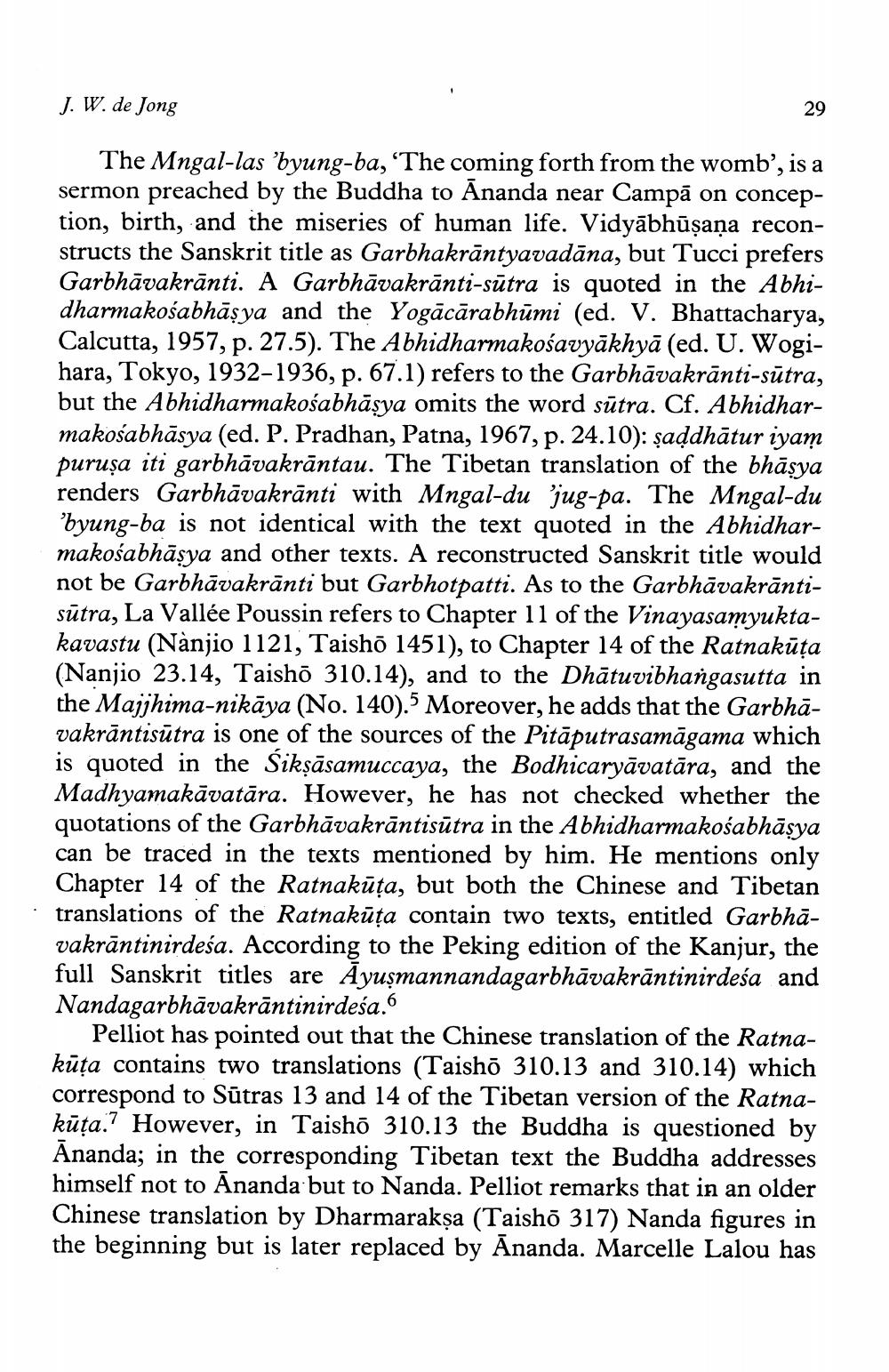________________
J. W. de Jong
The Mngal-las 'byung-ba, 'The coming forth from the womb', is a sermon preached by the Buddha to Ananda near Campā on conception, birth, and the miseries of human life. Vidyābhūṣaṇa reconstructs the Sanskrit title as Garbhakrāntyavadāna, but Tucci prefers Garbhāvakrānti. A Garbhāvakrānti-sūtra is quoted in the Abhidharmakośabhāsya and the Yogācārabhūmi (ed. V. Bhattacharya, Calcutta, 1957, p. 27.5). The Abhidharmakośavyākhyā (ed. U. Wogihara, Tokyo, 1932-1936, p. 67.1) refers to the Garbhāvakrānti-sūtra, but the Abhidharmakośabhāsya omits the word sūtra. Cf. Abhidharmakośabhāsya (ed. P. Pradhan, Patna, 1967, p. 24.10): şaờdhātur iyam puruṣa iti garbhāvakrāntau. The Tibetan translation of the bhāsya renders Garbhāvakrānti with Mngal-du 'jug-pa. The Mngal-du
byung-ba is not identical with the text quoted in the Abhidharmakośabhāsya and other texts. A reconstructed Sanskrit title would not be Garbhāvakrānti but Garbhotpatti. As to the Garbhāvakrāntisūtra, La Vallée Poussin refers to Chapter 11 of the Vinayasamyuktakavastu (Nanjio 1121, Taisho 1451), to Chapter 14 of the Ratnakūta (Nanjio 23.14, Taisho 310.14), and to the Dhātuvibhangasutta in the Majjhima-nikāya (No. 140). Moreover, he adds that the Garbhāvakrāntisūtra is one of the sources of the Pitāputrasamāgama which is quoted in the Sikşāsamuccaya, the Bodhicaryāvatāra, and the Madhyamakāvatāra. However, he has not checked whether the quotations of the Garbhāvakrāntisūtra in the Abhidharmakośabhāsya can be traced in the texts mentioned by him. He mentions only Chapter 14 of the Ratnakūța, but both the Chinese and Tibetan translations of the Ratnakūța contain two texts, entitled Garbhāvakrāntinirdeśa. According to the Peking edition of the Kanjur, the full Sanskrit titles are Āyuşmannandagarbhāvakrāntinirdeśa and Nandagarbhāvakrāntinirdeśa.
Pelliot has pointed out that the Chinese translation of the Ratnakūța contains two translations (Taisho 310.13 and 310.14) which correspond to Sūtras 13 and 14 of the Tibetan version of the Ratnakūța.? However, in Taisho 310.13 the Buddha is questioned by Ananda; in the corresponding Tibetan text the Buddha addresses himself not to Ananda but to Nanda. Pelliot remarks that in an older Chinese translation by Dharmaraksa (Taisho 317) Nanda figures in the beginning but is later replaced by Ananda. Marcelle Lalou has




